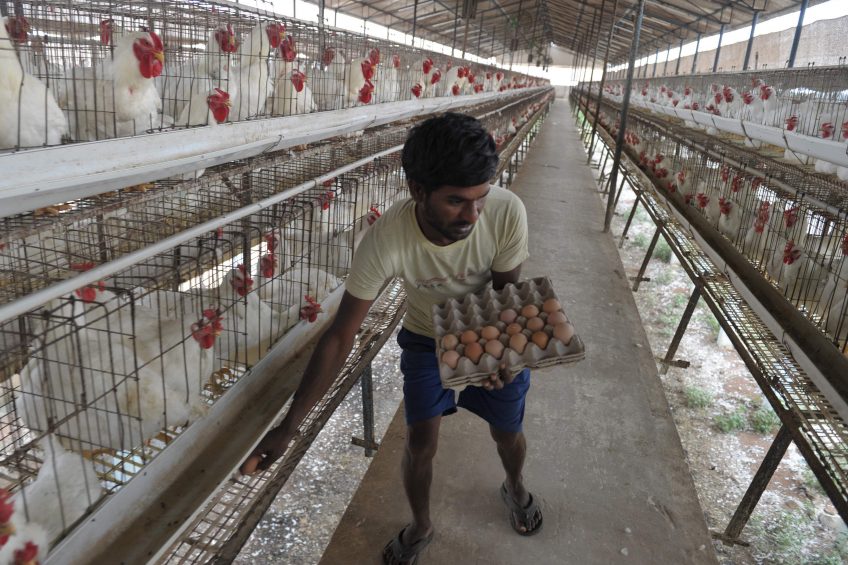Indian poultry producers cash in

Even as the Indian government is considering rolling back its plan of implementing a ban on the sale of cattle for slaughter in animal markets, poultry producers in India continue to cash in on the rising demand for chicken.
A slump in the cost of feed, which typically makes up two-thirds of poultry production costs, and rising chicken demand in the wake of the cattle slaughter restriction, has paved the way for cash registers to ring loud and clear across the country.
“Egg prices have gone through the roof, soaring almost 100% in 2017,” says Raju Shewale, who heads the Mumbai Eggs Association. “An egg that was available in the market for Rs 4 ($ 0.06) now costs Rs 8 ($ 0.12). Prices are likely to stay stable in the near future as production is normalising. In the meantime though, chicken farmers are making hay while the sun shines,” he adds.
A bumper harvest of soymeal and corn after two years of drought that had crimped grain output has resulted in cheaper feed, allowing poultry farmers to rake in huge profits.
Sanjeev Mahadik, a Pune based chicken farmer says eggs in the region were retailing at Rs 729 ($ 11.32) for every 100 pieces. Prices have come down slightly, though higher prices were also witnessed in south India especially in Hyderabad and Tamil Nadu, and in the Delhi-National Capital Region, in Kolkata in east India, and in Punjab and Jharkhand in north India.
Chicken prices, too, have soared, with broiler prices ranging between $ 2.58-$ 1.87 per kilo though they have slackened to around $ 1.40.
“The average farm gate chicken price in Maharashtra has increased from $ 1 at the end of November to the current $ 1.40 per kilo, a rise of close to 40%,” says Hashim Quereshi, poultry farmer. Chicken sales in Mumbai have also increased from about 500,000 to 600,000 birds per day to about 800,000 to 1 million birds per day, he said adding that typically, sales of chicken tend to go up by about 25% during winter.
Pointing out that the spike in egg and broiler prices was linked to India’s beef export trade crash, Quereshi said India’s beef ban and related controversies had come as a blessing in disguise for poultry farmers. “The government’s decision had a big impact not only on the beef industry, but also on farmers selling the cattle,” he says.
Respect for bovine
In 2017, India notified rules to prevent the sale of cows, buffaloes and other bovines for slaughter at markets. However, the crackdown on illegal slaughterhouses started in March, two months prior to the government notification. The rules were implemented by the Central government, which is made up of a Hindu majority. An immediate backlash was not unexpected. Despite the fact that cows are considered sacred by a large section of the Indian population, the country is also one of the leading exporters of cattle meat with millions employed in the meat industry and related works such as tanning and the leather industry, exploited mainly by Muslim and Christian minorities. “Banning the sale of cattle for slaughter in the open market meant 80%-90% business disappeared instantly,” says Quereshi.
The government, at the Centre, came under severe attack for the slaughter ban notification from several quarters. The whole issue took on political overtones and became a Centre versus States issue, with States like Kerala and Meghalaya passing resolutions against the Centre’s law, asserting that they would not implement it.
Though a majority of the farmers supported the cow slaughter ban, several cow vigilante groups, who portray themselves as protectors of cows, sprang up across the country, carrying out a ruthless form of mob justice, thrashing and even killing those suspected of cow smuggling, trading, or consuming beef.
Immediately after the institution of the ban, there were reports of more than a dozen lynchings across the country. Reports of stray, abandoned cattle damaging crops and wrecking havoc, and incidents of acid attacks on cows and the consequent uproar has now forced the government to consider rolling back the cattle slaughter ban.

Chicken consumption soaring
Incidentally, the raging controversy over beef consumption in India had an unexpected fallout, on chicken demand and price. “Cow smuggling is not new in India. The activism by cow protection groups and cow vigilantes is,” says an official at the Poultry Federation of India, a national level association of poultry farmers.
Stating that the last seven months have been very severe for cattle farmers, the official said a fallout was chicken prices in many parts of the country started soaring, with chicken consumption also rising by around 35% to 40%.
An analysis by industry body Assocham’s Economic Research Bureau showed between May 2014 and March 2017, the poultry wholesale price index rose over 22% in India, while that of beef and buffalo meat declined about 3%. Higher vegetable prices too have aided the trend. Raju Bhosale, executive member of the National Egg Coordination Committee, an association of poultry farmers in India, attributes the jump in egg prices to an estimated 19% jump in demand for the protein rich food. “As winter sets in, there is a surge normally in the demand for eggs across the country. In 2017 though it has been remarkably high,” he says. Traders also say when egg prices are good, farmers tend to maintain the birds till 90 weeks, even if laying happens only once in 35-36 hours.
“Given the meat shortage, many egg-laying hens went to the slaughter house earlier to keep up with the increased demand. When the demand for chicken stabilises, birds are not culled before 90 weeks,” says Bhosale. Traders say the current slight lull in prices would see an uptick in demand for eggs and chicken. The rise in demand will continue.













